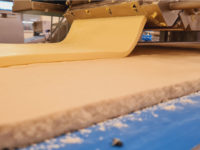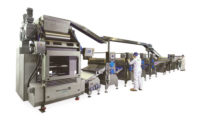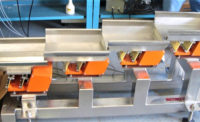Automation, performance, maintenance top of mind for ingredient handling customers
Advancing technologies help streamline operations.

courtesy of Key Technology
Snack food and wholesale bakery companies in the market for machines that help prepare, store, transport, and otherwise handle ingredients are most focused on qualities like automation, ease of maintenance, and the ability to deliver higher performance in throughput and accuracy.
Customers of Key Technology, Inc., Walla Walla, WA, want automated inspection systems that enable the sorter to share intelligent information about the product, including report generation, according to Marco Azzaretti, director of marketing. “They want not just its function as a sorter but also want it to act as a smart information analytics tool,” he says. “At the same time, and this is true with any type of equipment, we’re seeing certainly trends toward ease of use, and ease of maintenance for the equipment. Those two attributes have always been desirable when it comes to food technology, and automation.”
The purpose of automation increasingly revolves around reducing headcount, Azzaretti says. “With fewer people around, and also operators not having a technical skill set, it’s extremely important as we continue to deliver more performance, that that performance also comes in a package that’s even easier to use and easier to maintain than before,” he says. “All of the performance that we can deliver to a customer is absolutely for naught, we’re being told, if it comes at the expense of more complexity, more maintenance. We’re being called upon to deliver the best of both worlds.”
Customers of optical sorting company TOMRA Food, Asker, Norway, are getting considerably more demanding about product quality assurance, precisely because their customers, in turn, are doing the same, says Brendan O’Donnell, global category director, nuts and dried fruit.
“Twenty years ago, if you were selling almonds, a ‘low foreign material’ ratio would be 20 pieces per ton. Now, you’d get laughed out of the building,” he says. “They’re asking for ways to get that foreign material count down to two pieces per ton, or one piece per two tons. They’re focused on the data and want information on what those machines are seeing to help validate the quality of the product they’re buying.”
Snack and bakery customers also want to do ingredient handling jobs with as few runs as possible, which means keeping false rejects to a minimum, O’Donnell says. “Most processors will tell you they spend 80% of their time running 20% of their product—going over and over it, cleaning to get down to a good product,” he says. “One of the things we’ve done is taught the machines how to target the center of an object, rather than a defect.”
For example, if a piece of shell is sticking out of an almond, previous generations of machines would air to attempt to blast it out, O’Donnell says. “But that might miss it, or hit another shell. Our new machines have more precise and accurate ejection,” he says.
To meet demand, equipment manufacturers have been running full tilt for a couple of years, says Chuck Kerwin, general manager and sales manager at AZO Inc., Memphis, TN. It’s increasingly difficult to take on new business. “There’s a pressing need, and that need may not be fulfilled for a while…”
In the past, it was significantly easier to place an order and receive it quickly, Kerwin says. Food industry customers face a two-part dilemma because the difficulties finding adequate manpower make it challenging to adequately maintain existing machines, as well. “We’ve see an increase in spare parts orders, so some maintenance is being done,” he says. “But without basic fine-tuning—a materials handling system is designed in such a way that it could be underperforming, and you don’t realize that.”
For example, Kerwin says, if a mixer is supposed to weigh and convey 2,000 pounds of flour in 1½ minutes, and the system isn’t maintained properly, that might take 2 or 2½ minutes instead. “It’s still working, but there’s an efficiency issue,” he says. “If the other weighments are taking longer than they should, you begin to materially impact the throughput and, ultimately, the capacity of the production line. It’s kind of a slow death by 1,000 cuts.”
Some might say that if a machine is working, “We shouldn’t mess with it,” Kerwin adds. “The question is, ‘Is it working well?’”
AZO Inc.
Automated Raw Material Handling
AZO Inc., Memphis, TN, engineers automated vacuum conveying of raw materials like powdered bulk components for the manufacture of baked goods, with a priority of reducing manual labor input.
AZO Inc. continues to get requests for additional automation features on its ingredient handling machines, although customers always want to know about how quickly the return on investment will pay off. Chuck Kerwin, general manager and sales manager, thinks that ROI comes sooner than some believe, given the issues related to finding enough labor at the present time.
“The idea is, ‘We’re doing it manually, and we’ve got one person per shift doing the work. So, if we automate, we can do all the work in one shift with one person, and two take people out of the mix,’” says Kerwin. “That doesn’t take into account the fact that there’s nobody working third shift. They can’t find anybody. They have to pay the guy on first shift overtime to prepare batches they need for third shift.” If you’re scrambling around and cutting corners to just “make do” with fewer people than you need to run, he advises, your automation payback should be much better.
Key Technology
Varyx 2.0, Zephyr
Key Technology, Walla Walla, WA, produces automated inspection systems that optically inspect a flow of product for different types of quality attributes definable by the customer, and that automatically remove contaminants or foreign materials, says Marco Azzaretti, director of marketing. Last October the company unveiled the latest version of its optical sorter, the Varyx 2.0 platform, which has added inspection features and new types of sensors available to more accurately identify defects and contaminants for removal from the product stream.
“The other thing that’s noteworthy about Varyx 2.0 is its information analytics capabilities,” Azzarretti says. “The sorter obviously does what is its job to do, to remove defects and contaminants that don’t belong in the product stream. But it also acts as a bit of an information center for the process line because it shares data about the process, and about the quality attributes of literally every single piece of product that flows underneath it.”
Key Technology also supplies vibratory handling technology that not only moves a product from point A to point B but also is designed to feed different types of processing equipment. To this end, Key has launched a product called Zephyr that’s a horizontal motion conveyor notable due to its ability to transport and very gently handle food products and ingredients, he says.
“Any product that is a high-value product and/or is delicate or fragile—subject to breakage or degradation if it’s handled too roughly through the conveyance process—Zephyr is a solution to convey the product with the ultimate gentle handling, in order to preserve intact the physical properties of the product,” Azzaretti says.
TOMRA Food
TOMRA 5C
Last year, TOMRA Food, Asker, Norway, released the TOMRA 5C, which succeeded the Nimbus. It uses high-resolution laser imagery, front and rear hyperspectral cameras that use 16 channels instead of the usual three (red/green/blue), and biometric signature identification (BSI) technology to differentiate size, shape and color. As such, it catches tiny defects like an embedded piece of shell the width of a fingernail, or an interloping allergen like a peanut in a pistachio line, says Brendan O’Donnell, global category director, nuts and dried fruit.
The 5C also provides ease of use and ease of sanitation, starting with doors like on a Lamborghini that fold outward. That means employees are not only going to clean it, but do it better, says O’Donnell. “It also has hygienic seals on the optical boxes, and no flat surfaces for microbial hot spots.”
Beyond that, TOMRA provides stand-alone digital solutions that offer the ability to analyze data that machines are capturing—telling the user whether every single almond being analyzed is a good or bad piece of product, and more recently enabling cloud-computing analysis that displays what’s happening in the middle of the night, when machines are down and then back up again, and what alarms are sounding, O’Donnell says.
This includes the TOMRA Visual Assist app, a FaceTime-like function that allows an operator to be standing next to a machine and point to what’s happening, at a “plant in the middle of nowhere, when they need help right away,” he says. A remotely located engineer can see the machine or take screenshots and be able to provide solutions, as well as log into the machine, change existing programming, or create new programs. TOMRA Insight provides the cloud computing and data analysis.
Looking for a reprint of this article?
From high-res PDFs to custom plaques, order your copy today!







